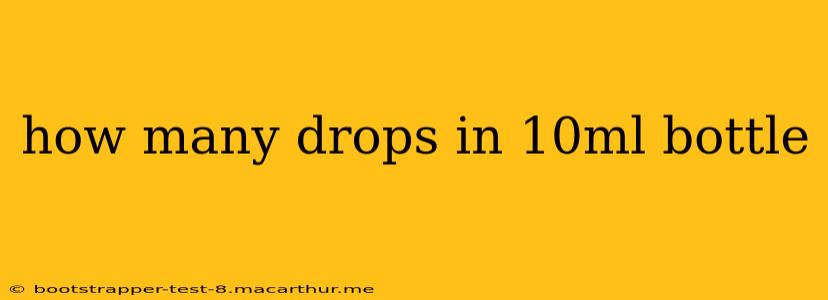How Many Drops Are in a 10ml Bottle? It's Trickier Than You Think!
The seemingly simple question, "How many drops are in a 10ml bottle?" doesn't have a straightforward answer. The number of drops in a 10ml bottle varies significantly depending on several factors. While you might find online calculators offering a precise number, these are often misleading due to these inconsistencies. Let's dive into the complexities:
What Factors Affect the Number of Drops?
Several key factors influence the number of drops you'll get from a 10ml bottle:
-
The Liquid's Viscosity: Thick liquids like honey or syrup will produce fewer, larger drops than thin liquids like water or alcohol. The higher the viscosity, the larger the drop volume.
-
The Dropper's Design: Different droppers have different orifice sizes (the opening through which the liquid flows). A dropper with a larger opening will deliver larger drops than one with a smaller opening. The material of the dropper can also affect the surface tension and hence the drop size.
-
The Temperature: Temperature influences the viscosity of a liquid. Warmer liquids are generally less viscous and will produce smaller drops.
-
Surface Tension: The surface tension of the liquid plays a vital role in determining drop size. Liquids with higher surface tension form larger drops. This is influenced by the liquid's composition and temperature.
So, How Many Drops Approximately?
While a precise number is impossible without specifying the exact liquid and dropper, a common estimate is that there are approximately 20 drops per milliliter (ml). Using this estimate, a 10ml bottle would contain approximately 200 drops.
However, this is just a rough estimate. You could easily have fewer or more drops depending on the factors outlined above. For example:
- Thick liquids: Expect significantly fewer than 200 drops.
- Thin liquids with a large-orifice dropper: Expect more than 200 drops.
How Can I Get a More Accurate Count?
For a more precise measurement, consider these options:
- Experiment: Use the specific dropper and liquid you intend to use and count the drops per milliliter. This method is the most accurate and relevant to your specific scenario. Measure out a small amount (e.g., 1 ml) and carefully count the drops.
- Specialized Equipment: In scientific settings, specialized equipment is used to precisely measure drop volume.
Why Isn't There a Standard?
There's no universally agreed-upon standard for drop size because of the variability discussed above. The size of a drop is not a consistent unit of measurement in the way that milliliters or grams are. This makes it unsuitable for precise calculations in many applications.
In Conclusion
While a quick online search might offer a simple answer, remember that the number of drops in a 10ml bottle is highly variable. Always consider the type of liquid and the dropper's design when attempting to estimate the number of drops. For accurate measurement, perform your own experiment or use appropriate scientific equipment.
